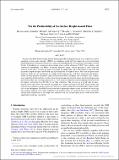| dc.contributor.author | Andres, Magdalena | |
| dc.contributor.author | Musgrave, Ruth C | |
| dc.contributor.author | Rudnick, Daniel L | |
| dc.contributor.author | Zeiden, Kristin L | |
| dc.contributor.author | Peacock, Thomas | |
| dc.contributor.author | Park, Jae-Hun | |
| dc.date.accessioned | 2022-01-11T19:48:36Z | |
| dc.date.available | 2022-01-11T19:48:36Z | |
| dc.date.issued | 2020 | |
| dc.identifier.uri | https://hdl.handle.net/1721.1/138889 | |
| dc.description.abstract | As part of the Flow Encountering Abrupt Topography (FLEAT) program, an array of pressure-sensor equipped inverted echo sounders (PIESs) was deployed north of Palau where the westward-flowing North Equatorial Current encounters the southern end of the Kyushu–Palau Ridge in the tropical North Pacific. Capitalizing on concurrent observations from satellite altimetry, FLEAT Spray gliders, and shipboard hydrography, the PIESs’ 10-month duration hourly bottom pressure p and round-trip acoustic travel time t records are used to examine the magnitude and predictability of sea level and pycnocline depth changes and to track signal propagations through the array. Sea level and pycnocline depth are found to vary in response to a range of ocean processes, with their magnitude and predictability strongly process dependent. Signals characterized here comprise the barotropic tides, semidi-urnal and diurnal internal tides, southeastward-propagating superinertial waves, westward-propagating mesoscale eddies, and a strong signature of sea level increase and pycnocline deepening associated with the region’s relaxation from El Niño to La Niña conditions. The presence of a broad band of super-inertial waves just above the inertial frequency was unexpected and the FLEAT observations and output from a numerical model suggest that these waves detected near Palau are forced by remote winds east of the Philippines. The PIES-based estimates of pycnocline displacement are found to have large uncertainties relative to overall variability in pycnocline depth, as localized deep current variations arising from interactions of the large-scale currents with the abrupt topography around Palau have significant travel time variability. | en_US |
| dc.language.iso | en | |
| dc.publisher | American Meteorological Society | en_US |
| dc.relation.isversionof | 10.1175/JPO-D-19-0310.1 | en_US |
| dc.rights | Article is made available in accordance with the publisher's policy and may be subject to US copyright law. Please refer to the publisher's site for terms of use. | en_US |
| dc.source | American Meteorological Society (AMS) | en_US |
| dc.title | On the predictability of sea surface height around Palau | en_US |
| dc.type | Article | en_US |
| dc.identifier.citation | Andres, Magdalena, Musgrave, Ruth C, Rudnick, Daniel L, Zeiden, Kristin L, Peacock, Thomas et al. 2020. "On the predictability of sea surface height around Palau." Journal of Physical Oceanography, 50 (11). | |
| dc.contributor.department | Woods Hole Oceanographic Institution | |
| dc.contributor.department | Massachusetts Institute of Technology. Department of Mechanical Engineering | |
| dc.relation.journal | Journal of Physical Oceanography | en_US |
| dc.eprint.version | Final published version | en_US |
| dc.type.uri | http://purl.org/eprint/type/JournalArticle | en_US |
| eprint.status | http://purl.org/eprint/status/PeerReviewed | en_US |
| dc.date.updated | 2022-01-11T19:36:06Z | |
| dspace.orderedauthors | Andres, M; Musgrave, RC; Rudnick, DL; Zeiden, KL; Peacock, T; Park, J-H | en_US |
| dspace.date.submission | 2022-01-11T19:36:08Z | |
| mit.journal.volume | 50 | en_US |
| mit.journal.issue | 11 | en_US |
| mit.license | PUBLISHER_POLICY | |
| mit.metadata.status | Authority Work and Publication Information Needed | en_US |
